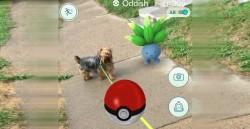Culture | July 29th, 2016

by Ben Haugmo
By now, we’ve all most likely heard about Pokémon Go, the mobile spin-off of Nintendo’s hit franchise, that is seeing players venture out of their homes and into the wild frontier of an augmented reality thriving with the ever-elusive pocket monster.
The game has overcome the hiccups of its initial launch to become a huge success, but it is yet to be seen if Pokémon Go will have permanent staying power. The outlook seems optimistic, with promises of server fixes, new features, and of course the addition of the remaining roster of over 700 creatures over the coming years.
Gameplay involves searching the local area for encounters with Pokémon. Common species like Pidgey are found in abundance, but the rarer types of Pokémon will require a little hiking to find.
Unlike the original games, rather than pitting your own Pokémon in battle against those discovered in the wild, capturing them is as simple as throwing a Pokéball, an action represented by a flick of the finger over your smart phone’s screen. Pokéballs and other items can be obtained at PokéStops, located at monuments and other locations of interest.
Pokémon can have their strength increased and be evolved through the use of candy earned with subsequent captures of Pokémon of the same species. The omnipresent Pidgey yields Pidgey candy, which can be used to evolve it into its second form, Pidgeotto, and from there into its final iteration, Pidgeot.
As players discover new Pokémon and PokéStops, their character will level up. Upon achieving level 5, they are able to choose from one of three teams: Valor, Instinct, or Mystic. They can then battle with their Pokémon against other players at gyms, which can then be captured for their chosen team.
Pokémon Go launched in a rocky state. On release, the game was plagued by crashes, an overall lack of the features indicative of a true Pokémon game, and server issues that continue to persist, even as the company moves to push the game to other regions. Over a month after its release in the United States, Pokémon Go still feels like an unfinished product.
At the same time, despite its flaws, Pokémon Go has proven widely successful, topping app store charts and overtaking apps such as Twitter and Facebook in usage. Pokémon masters-to-be are drawn to locations that they might never have discovered if it weren’t for the desire to locate and capture the rare creatures. Hours are spent on the journey originally found on Nintendo handhelds, now translated to real life.
Pokémon Go’s developer, Niantic, isn’t new to creating augmented-reality games. Much of Pokémon Go’s infrastructure is from the company’s previous success, Ingress. Locations of interest in Ingress correspond to PokéStops and gyms.
The framework was in place, but Niantic’s small team was not prepared for the monumental attention the game received in its first few weeks, resulting in the prevailing server overcapacities that afflict players.
During last week’s San Diego Comic-Con, Niantic CEO John Hanke appeared in an interview to say that, yes, the servers were being worked on. After the servers are made more reliable, Pokémon Go players can expect several new features to fill in the gaps of an arguably simplified Pokémon game.
Trading Pokémon was one of the notable omissions during the game’s initial launch. The inclusion of this feature will not only bring Pokémon Go closer in line to the main series of games, but also allow players to assist each other in the goal of collecting every Pokémon.
Currently absent from the game are legendary Pokémon, such as the elemental bird trio Moltres, Zapdos, and Articuno, each of which serves as a mascot for one of the game’s three teams. Hanke assured the crowd at Comic-Con that legendary Pokémon would be appearing soon.
At present, every Pokémon is not accounted for in Pokémon Go. With 20 years of history behind it, the Pokémon franchise has had plenty of time to accumulate a vast bestiary of fantastic creatures. The full list sits at 721 Pokémon, of which 142 are currently available to capture in Pokémon Go. Eventually, more Pokémon will be added to the world for players to capture.
Hanke hinted that PokéStops would be able to be transformed into Pokémon Centers in updates to come, allowing Pokémon to be healed after being injured in battle, as well as providing other benefits.
Also revealed during Comic-Con were the identities of each of the three team’s leaders. Ingress featured an extensive storyline chronicling the conflict between its two factions. It will be interesting to see how Niantic utilizes the three-way split shown in Pokémon Go.
Pokémon Go is, ultimately, a very subjective experience. Some of us open the app to idly capture Pokémon as they appear on a bus ride across town. Others will gather friends together, bottled water and external phone batteries packed and ready for a quest dreamed about since childhood. Still others won’t bother with the game, decrying it as too simplistic, a watered-down, buggy simulacrum of the main franchise.
Hopefully Niantic’s strides toward improving Pokémon Go will make it all the more enjoyable for fans and give naysayers pause. Only time will tell if Pokémon Go will continue to catch the public’s attention.
December 18th 2025
October 20th 2025
October 15th 2025
September 16th 2025
July 29th 2025


_(1)_(1)_(1)_(1)__293px-wide.jpg)
__293px-wide.jpg)
__293px-wide.jpg)
_(1)_(1)_(1)_(1)__293px-wide.jpg)